Krakow not only musically
A small group of travel-loving readers visited the old Polish royal city from October 10 to 13.
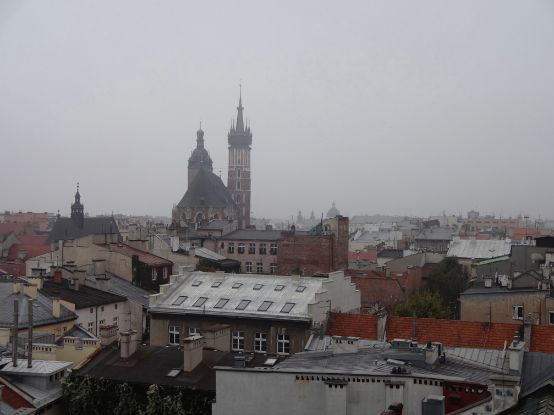
Nine expectant people gathered at Zurich Airport on the evening of October 10 to fly to Krakow with editor-in-chief and tour guide Katrin Spelinova. However, we had to save our curiosity about the city in the south of Poland until the next morning and were content to move into our rooms in the very comfortable and modern Andel's Hotel after our late arrival.
-
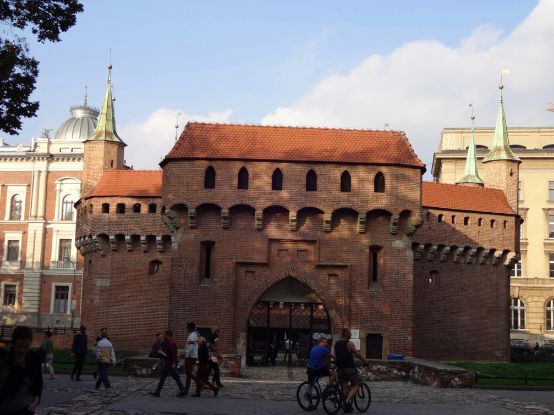
Barbican
On a foggy Saturday morning, our perfectly German-speaking and very competent Polish tour guide picked us up for our first sightseeing tour. She first took us to the old town, just a few minutes' walk away, which has been a UNESCO World Heritage Site since 1978. We passed the Barbican, a defensive bulwark from the 15th century, and the Florian Gate, the only remaining gate in Krakow's city walls and the start of the so-called Royal Route, which led Polish kings through the city center to Wawel Castle for many centuries. But first things first!
-
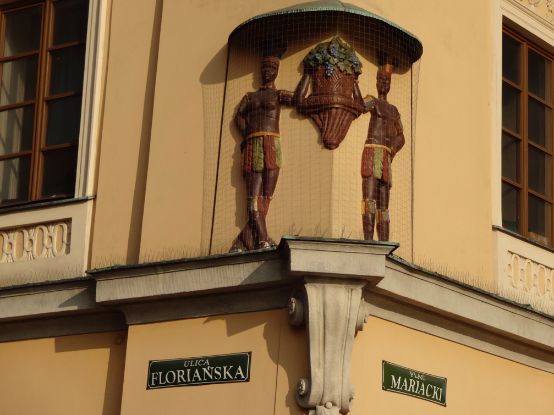
Corner of Florianstrasse and Marienstrasse
The first part of this royal road and probably the most famous street in the city is Florianska. Today it is a lively pedestrian zone with numerous restaurants, stores and bureaux de change. Stately town houses line it and bear witness to a long history.
-
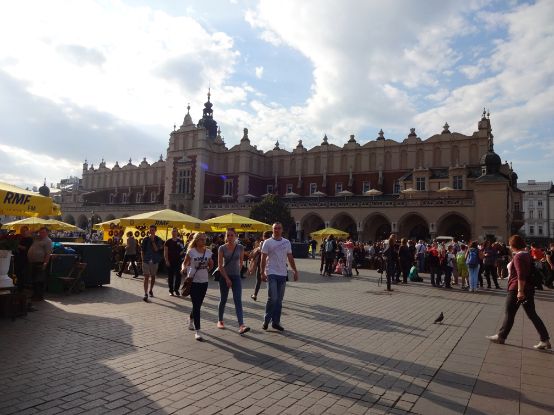
Market square with cloth halls
We soon reached the main market, the actual center of Krakow in the heart of the old town. With its impressive dimensions of 200 by 200 meters, it is one of the largest medieval market squares in Europe. It was laid out in this form as early as 1257.
-
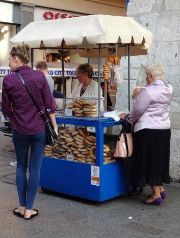
Obwarzanki sales stand
Flower stalls under bright yellow parasols, jugglers, hackney carriages with elaborately decorated horse-drawn carriages waiting for customers, the ubiquitous small blue vending carts with tempting obwarzanki (a ring-shaped yeast pastry), flocks of pigeons and many cheerful locals and tourists enliven the square and create a cheerful, almost Mediterranean atmosphere against a medieval backdrop. Two of Krakow's landmarks can be found on the main market square: the red and yellow Renaissance building of the Tuchhallen and St. Mary's Church with its two towers of different heights. Typical souvenirs such as amber jewelry, wood carvings, ceramics and animal skins are sold in many small wooden stalls in the Cloth Halls. However, we had to postpone our shopping trip until later, as our tour continued along the Royal Route through Grodzka Street towards Wawel.
-
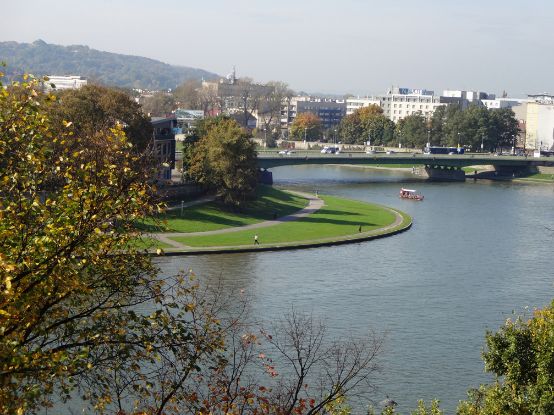
View of the Vistula from Wawel Castle
The castle and cathedral are located on a small hill directly on the banks of the Vistula.
-
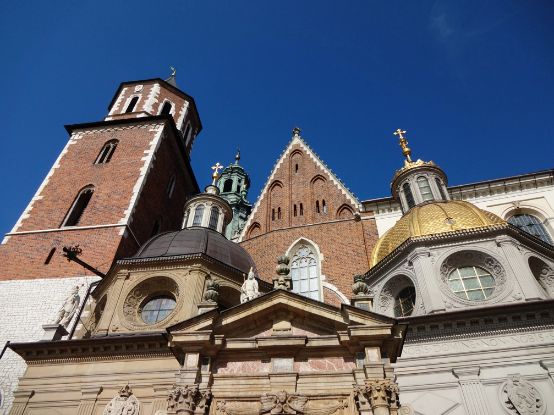
Wawel Castle
Over the course of its eventful history, the castle has been repeatedly rebuilt and renovated. Today, the former royal residence is home to several museums and is a magnet for all visitors to Krakow. We passed through a magnificent arcaded courtyard into the royal chambers with their frescoes, wooden ceilings and valuable tapestries from the 16th century, which fortunately have survived all wars and fires. We were particularly impressed by the painting Lady with the erminewhich Leonardo da Vinci painted in 1489 as one of only four portraits of women. When we left the castle at midday, we were surprised by bright sunshine, the fog had finally lifted. Before our well-deserved lunch break, however, we still had a visit to the Wawel Cathedral on the agenda. It is considered one of the most important places of worship in Poland. Polish kings were crowned here and many of them rest in huge sarcophagi in the central nave and in the crypt. A narrow spiral staircase leads to the Sigismund Tower with the 12-ton Sigismund bell.
-
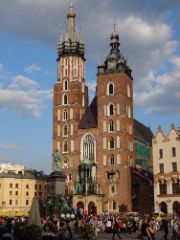
St. Mary's Church
Our first destination in the afternoon was the aforementioned Gothic St. Mary's Church, built between the 13th and 15th centuries. The interior owes its special atmosphere to the countless stars on the blue-painted ceiling and the colorful stained glass windows. The main attraction, however, is the late Gothic high altar by Nuremberg sculptor Veit Stoss. The largest figures, modeled on citizens of Krakow, are 2.7 meters high and look extremely lifelike. It is hard to believe that they are carved from lime wood.
We continued on to the university district. The Collegium Maius is the oldest building of the venerable Jagiellonian University. It was founded in 1364 and is the second oldest university in Central Europe after Prague. To this day, Krakow has remained an important university city and the many students and young people are an unmistakable feature of the cityscape.
-
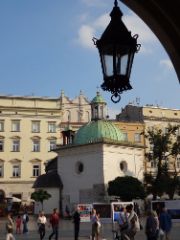
Adalbert Church on the market square
Back on the market square, a concert by a string quartet awaited us in the tiny Adalbert Church, which is a real oasis of calm in the midst of the hustle and bustle. The program was a colourful mix, ranging from Mozart, Handel and Vivaldi to Gershwin and film melodies. Afterwards, we had dinner together in the Jarema restaurant, where we were treated to Polish specialties and folk music and exchanged our impressions of this very interesting, but also exhausting first day.
Our bus was ready at 8 a.m. on Sunday morning to take us to the salt mine in Wieliczka, south-east of Krakow, which has also been awarded Unesco status. Salt was mined here from the Middle Ages until the mine ceased operations in 1993. The caves and tunnels extend over 300 km. On a two-kilometer tour through this unique world, we learned a lot about the often dangerous work of the miners and salt extraction. Salt lakes, sculptures, halls and the largest underground church in the world, all made of salt, left us amazed.
-
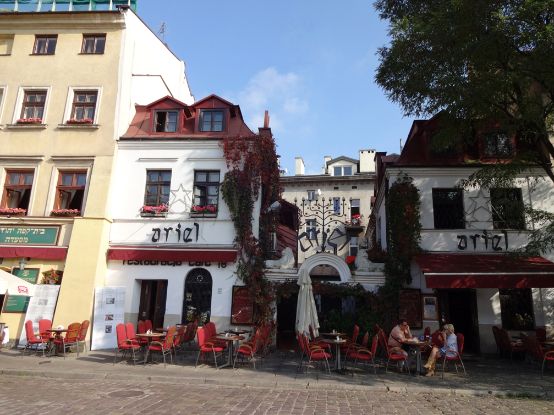
Breite Strasse in Kazimierz
We spent the afternoon in Kazimierz, which used to be an independent town and is now part of Krakow. The Jews in Krakow once enjoyed great freedom and extraordinary rights. When they were later persecuted, they moved to neighboring Kazimierz. However, the Nazis destroyed the flourishing Jewish culture and only 4,000 of the 60,000 Jews survived the war. Today, the district is a popular place to go out, with its many restaurants and a completely different atmosphere to the rest of the city. Colorful but small houses built next to each other line Breite Strasse, the former market square.
-
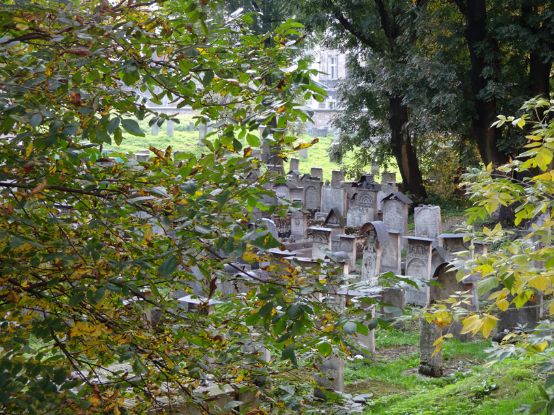
Old cemetery near the Remuh synagogue
There are three important synagogues here, including the Remuh Synagogue with its old cemetery. Visiting this synagogue, which is still in active use today, was probably a special experience for most of our group. The visit to the weathered gravestones with their mysterious signs and inscriptions in the old cemetery also left a deep impression. A tour through the narrow streets and past other synagogues and important sites finally led us to Plac Nowy, the lively market square with numerous cafés and bars.
-
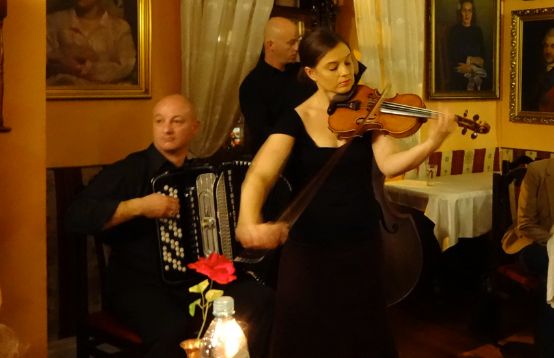
The Krakow klezmer ensemble Sholem
In the evening, a very special experience awaited us in the Ariel restaurant. Even the winding rooms with countless pictures on the walls created a special atmosphere. We were served a tasting menu of Jewish-Polish delicacies at a long table. A highlight of the whole trip was the performance by the klezmer ensemble Sholem. Maciej Inglot on accordion and Tomasz Michalik on double bass as well as the singer and violinist Ewelina Tomanek entertained us with melodies from the rich Jewish folk music tradition. Their music was so fabulous and captivating that we were almost unable to keep our seats. It was a unique and successful end to the day.
The last stop on the program on Monday morning was a visit to the music academy. A graduate showed us around the premises and told us a lot of interesting facts about music education and training, which is extremely important in Poland. The children are encouraged from an early age and trained to a high standard. As at the concert on Saturday, we noticed that the boundaries between serious and popular music are much more fluid in Poland than here. In principle, everyone plays everything, although jazz is also of great importance and very popular throughout the country. We were given a musical taster in the organ hall and at the end of the tour the 25-year-old pianist Jerzy Owczarz interpreted compositions by his compatriots Karol Szymanowski and Fryderyk Chopin.
-
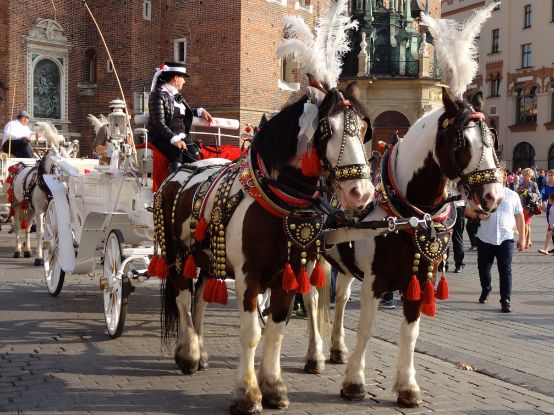
Horse-drawn carriage on the market square
The last few hours were just enough for a short farewell tour, either to spend the last zlotys in the Galeria Krakowska shopping center with its 270 stores or to stroll through the market again. We were soon driven to the airport and arrived back in Zurich two and a half hours late, but safe and sound.
Our short detour to Krakow was a trip full of highlights in a beautiful city steeped in history, which almost all of us visited for the first, but perhaps not the last time. I would like to pay special tribute not only to Katrin Spelinova for her prudent and competent tour guide, but also to all the other passengers, who were always in a good mood and interested. It was great fun traveling with you!
The trip was organized by
TourIQum Special Tours








